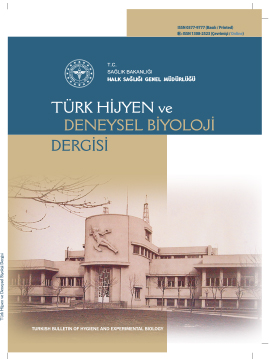
Bu eser Creative Commons Alıntı-GayriTicari-Türetilemez 4.0 Uluslararası Lisansı ile lisanslanmıştır.













The presence and distribution of high risk HPV types in simultaneous cervical cytology samples
Sibel Aydoğan1, Aylin Yazgan2, Emre Erdem Taş3, Ayşegül Gözalan1, Ayşe Filiz Yavuz3, Ziya Cibali Açıkgöz41Department of Medical Microbiology, Ankara Ataturk Training and Research Hospital, Ankara, Turkey2Department of Pathology, Ankara Ataturk Training and Research Hospital, Ankara, Turkey.
3Department of Gynecology and Obstetrics, Faculty of Medicine, Yildirim Beyazit University, Ankara, Turkey.
4Department of Medical Microbiology, Faculty of Medicine, Yıldırım Beyazıt University, Ankara, Turkey
INTRODUCTION: Human papillomavirus (HPV) is the most detected viral pathogen of reproductive system and almost all servical carsinomas are related to HPV. The incidance and mortality rate of cervical carsinomas are significantly on the decrease by means of early diagnosis and treatment as a result of screening programmes. The aim of the study is to evaluate the results of HPV DNA and cervical cytology specimens simultaneously in a three year period.
METHODS: The test results of 328 patients that were send to Molecular Microbiology Laboratory for HPV DNA and genotype between 2012-2014 were retrospectively analysed. The cytology results of the patients were reviewed simultaneously by pathology laboratory and reexamined if necessary. The relationship between cervical anomalies and the presence of HPV DNA and genotypes were evaluated. Cervical samples were collected in DigeneHC2 DNA Collection Device and DNA was isolated using QIAamp DNA Mini Kit. DNA samples were tested for high risk HPV infection by the Genotyping Kit HPV GP. Conventional (Papanicolau) smears were evaluated cytologically according to 2001 Bethesda System.
RESULTS: The median age of the patients was found 36 and there was no significant difference between the median ages of the HPV DNA negative and positive women. High risk HPV DNA was determined 110 out of 328 patients (33.5%) and multiple types were detected 22.7% of the cases. The most determined types were HPV-16/51/18/56. Abnormal cytology was detected from 21.5% of the 270 patients that were evaluated by pathologist simultaneously. The abnormal cytologic signs of the patients were reported as 48.3% ASCUS, 34.5% LSIL, 7% ASC-H, 7% HSIL and 3.5% AGUS. The HPV DNA positivity of the patients with abnormal cytologic results (50%) were found high significantly comparing the patients with normal cytology (28.3%) (p=0.002). The type 16 was determined 38% and 44% from the patients with abnormal and normal cytology, respectively.
DISCUSSION AND CONCLUSION: The genotyping of HPV plays an important role as the cervical cancer screening programmes are gaining importance globally. The determination of high rates of type 16 from patients with normal cytology proves that cytologic tests results should be supported by DNA typing and those patients should be followed up closely.
Eş zamanlı servikal sitoloji örneklerinde yüksek riskli HPV tiplerinin varlığı ve dağılımı
Sibel Aydoğan1, Aylin Yazgan2, Emre Erdem Taş3, Ayşegül Gözalan1, Ayşe Filiz Yavuz3, Ziya Cibali Açıkgöz41Ankara Atatürk Eğitim ve Araştırma Hastanesi, Tıbbi Mikrobiyoloji Laboratuvarı, Ankara, Türkiye2Ankara Atatürk Eğitim ve Araştırma Hastanesi, Patoloji Laboratuvarı, Ankara, Türkiye
3Yıldırım Beyazıt Üniversitesi, Kadın Hastalıkları ve Doğum Ana Bilim Dalı, Ankara, Türkiye
4Yıldırım Beyazıt Üniversitesi, Tıbbi Mikrobiyoloji Ana Bilim Dalı, Ankara, Türkiye
GİRİŞ ve AMAÇ: Human papillomavirus reprodüktif sistemin en sık görülen viral enfeksiyon etkenidir ve neredeyse tüm serviks kanseri olgularıyla ilişkisi gösterilmiştir. Servikal kanser tarama programları ile erken tanı ve tedavi sayesinde insidans ve mortalite oranları etkin bir şekilde azalmaktadır. Bu çalışmada üç yıllık bir süre içinde çalışılan HPV DNA test sonuçları ve eş zamanlı servikal sitoloji örneklerinin değerlendirilmesi amaçlanmıştır.
YÖNTEM ve GEREÇLER: 2012-2014 yılları arasında Moleküler Mikrobiyoloji Laboratuvarı’ na HPV DNA araştırılması ve genotip tayini amacıyla gönderilen 328 hastaya ait sonuçlar retrospektif olarak analiz edilmiştir. Ayrıca aynı hasta grubuna ait eş zamanlı sitoloji sonuçları da patoloji laboratuvarı tarafından retrospektif olarak değerlendirilmiş, gerek duyulan örnekler tekrar incelenerek, servikal anormallikler ile HPV varlığı ve genotipler arasındaki ilişkiler ortaya konulmuştur. Servikal örnek alımında DigeneHC2 DNA Collection Device® kullanılmış ve DNA eldesi QIAamp® DNA Mini Kit ile yapılmıştır. DNA örneklerinde yüksek riskli HPV tiplerinin varlığı Genotyping Kit HPV GP kullanılarak araştırılmıştır. Sitolojik değerlendirme konvensiyonel Papanicolau test ile yapılmış ve sonuçlar 2001 Bethesda Sistemi’ne göre yorumlanmıştır.
BULGULAR: Hastaların yaş ortancası 36 olup, test sonucu pozitif ve negatif kadınların yaş ortancaları arasında anlamlı fark bulunmamıştır. Yüksek riskli HPV DNA analizi yapılan 328 hastanın 110 tanesinde (%33.5) pozitif sonuç elde edilmiş ve %22.7 oranında multiple tip varlığı bulunmuştur. En sık saptanan tipler HPV-16/51/18/56 olarak belirlenmiştir. Hastaların 270’inde eş zamanlı sitolojik değerlendirme yapılmış ve %21.5 anormal sitoloji saptanmıştır. Anormal sitoloji saptanan hastaların sitolojik bulgulara göre dağılımı; %48.3 ASCUS, %34.5 LSIL, %7 ASC-H, %7 HSIL ve %3.5 AGUS şeklinde olmuştur. Anormal sitoloji saptanan hastalardaki HPV pozitifliği (%50), normal sitolojili hastalardaki HPV pozitifliğinden (%28.3) istatistiksel olarak anlamlı derecede yüksek bulunmuştur (p=0.002). Çalışmamızda Tip 16 anormal sitolojili grupta %38, normal sitolojili grupta ise %44 oranında saptanmıştır.
TARTIŞMA ve SONUÇ: Servikal kanser tarama programları tüm dünyada hızla önem kazanırken, HPV genotipleme önemli bir rol üstlenmektedir. Normal sitolojili hastalarda da Tip 16’nın yüksek oranda saptanması, sitolojik incelemenin mutlaka DNA çalışması ile desteklenmesi ve hastaların yakın takibe alınması gerekliliğini kanıtlamaktadır.
Manuscript Language: English
(1641 downloaded)


